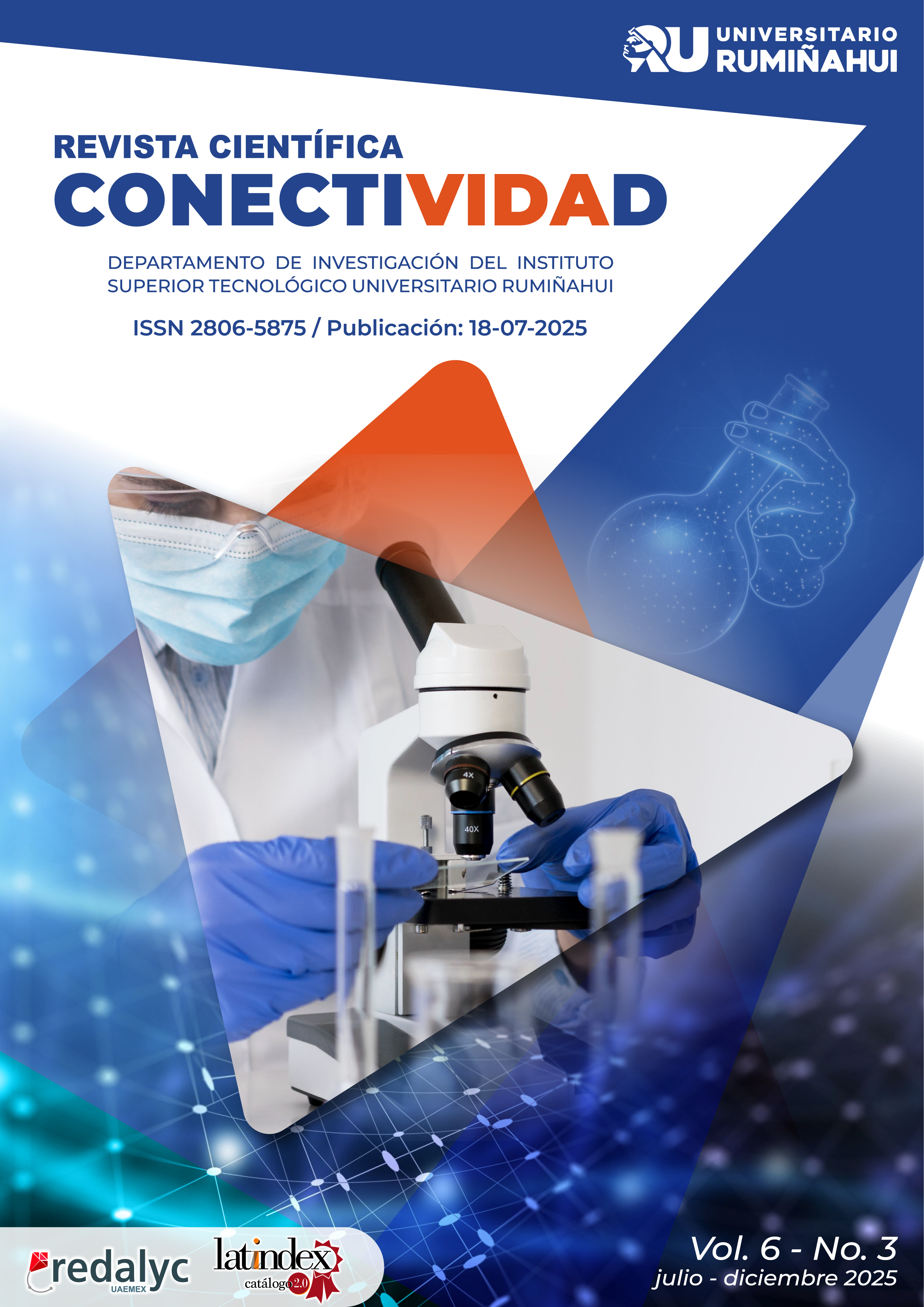Stress Reduction Strategies for University Professors through Digital Virtual Reality Environment: An Innovative Approach"
DOI:
https://doi.org/10.37431/conectividad.v6i3.251Keywords:
Work-related stress; teachers; mobile applications; digital intervention; virtual realityAbstract
Work stress in teachers is a growing problem with important implications for their physical and mental health. This study evaluates the effectiveness of an intervention program based on the use of virtual reality (VR) to reduce perceived stress in teachers at the Rumiñahui Technological Institute. The initial sample consisted of 103 teachers (62.1% men; 37.8% women; Age = 45.2 years; SD = 8.57), who responded to the adaptation of the Perceived Stress Scale (PSS). The initial results showed that 98% presented high stress levels (27-40 points). Subsequently, two groups were formed: an experimental group (n = 40), who participated in relaxation sessions through visual and auditory simulations with virtual reality glasses, and a control group without intervention (n = 63). After the intervention, the experimental group showed a significant reduction in stress levels, reaching a classification in the moderate stress range (14-26 points), while the control group maintained high stress levels. Statistical analysis using independent samples t-test confirmed significant differences between both groups (p < 0.05), supporting the effectiveness of the program. The results underline the potential of virtual reality as an innovative and accessible strategy for managing work stress, contributing to the improvement of psychological well-being and occupational health in the educational field.
References
Benítez-Abarca, G. M., Nájera-Lara, J. F., Benítez-Abarca, A. B., & Jacho-Guanoluisa, N. del P. (2025). Influencia del estrés laboral en el desempeño docente por competencias en docentes universitarios. INNOVA Research Journal, 10(1), 19-31. https://doi.org/10.33890/innova.v10.n1.2025.2612 DOI: https://doi.org/10.33890/innova.v10.n1.2025.2612
Berman, M. G., et al. (2024). Additively manufactured micro-lattice dielectrics for multiaxial capacitive sensors. Science, 383(6662), 67-72. https://doi.org/10.1126/science.ade5039
Bucci, S., Schwannauer, M., y Berry, N. (2019). La revolución digital y su impacto en la atención de la salud mental. Psicología y psicoterapia: teoría, investigación y práctica, 92 (2), 212-221. https://doi.org/10.1111/papt.12222 DOI: https://doi.org/10.1111/papt.12222
Cohen, S., Kamarck, T., & Mermelstein, R. (1983). A global measure of perceived stress. Journal of Health and Social Behavior, 24(4), 385-396. Recuperado de https://www.elsevier.es/es-revista-ansiedad-estres-242-avance-resumen-escala-estres-percibido-analisis-psicometrico-S1134793718301283 DOI: https://doi.org/10.2307/2136404
Equipo de edición de Vorecol. (2024, 11 de marzo). Integración de la inteligencia artificial en la terapia psicológica cognitivo-conductual. Vorecol. Recuperado de https://volmae.es/inteligencia-artificial-en-terapia-psicologica/
Equipo de edición de Vorecol. (2024, 29 de octubre). Herramientas digitales para la gestión del estrés y el bienestar emocional de los empleados. Vorecol. Recuperado de https://vorecol.com/es/articulos/articulo-herramientas-digitales-para-la-gestion-del-estres-y-el-bienestar-emocional-de-los-empleados-174808
Guerra Peña, K. (2024, 30 de octubre). Tecnologías emergentes en el apoyo a la salud mental. Listín Diario. Recuperado de https://listindiario.com/puntos-de-vista/20241030/tecnologias-emergentes-apoyo-salud-mental_831567.html
Idrovo, M. D. (2023). Aplicaciones digitales para meditación y autocuidado. Revista Para el Aula - IDEA-UxE, (47). Universidad San Francisco de Quito (USFQ). Recuperado de https://www.usfq.edu.ec/sites/default/files/2023-09/pea-047-014.pdf
Kaplan, R., & Ramanna, K. (2021). Accounting for climate change. Harvard Business Review. Recuperado de https://hbr.org/2021/11/accounting-for-climate-change
Lakhtakia, T. y Torous, J. (2022). Orientaciones actuales en intervenciones digitales para trastornos del estado de ánimo y la ansiedad. Current Opinion in Psychiatry, 35 (2), 130-135. https://doi.org/10.1097/YCO.0000000000000772 DOI: https://doi.org/10.1097/YCO.0000000000000772
Mero Macías, V. G., Galeas Guevara, J. J., Maldonado Jaramillo, J. del R., & Ríos Silva, M. A. (2023). Importancia de reducir el estrés laboral en los docentes. Revista Científica Multidisciplinaria Ogma, 2(1), 21-30. Recuperado de http://www.revistaogma.com DOI: https://doi.org/10.69516/dwf3cn42
Maples-Keller, JL, Bunnell, BE, Kim, SJ y Rothbaum, BO (2017). El uso de la tecnología de realidad virtual en el tratamiento de la ansiedad y otros trastornos psiquiátricos. Harvard Review of Psychiatry, 25 (3), 103-113. https://doi.org/10.1097/HRP.0000000000000138 DOI: https://doi.org/10.1097/HRP.0000000000000138
O'Connor, DB, Thayer, JF y Vedhara, K. (2021). Estrés y salud: una revisión de los procesos psicobiológicos. Revista anual de psicología, 72, 663-688. https://doi.org/10.1146/annurev-psych-062520-122331 DOI: https://doi.org/10.1146/annurev-psych-062520-122331
Orsolini, L., Longo, G., y Volpe, U. (2024). Aplicación práctica de la terapéutica digital en personas con trastornos del estado de ánimo. Current Opinion in Psychiatry, 37 (1), 9-17. https://doi.org/10.1097/YCO.0000000000000906 DOI: https://doi.org/10.1097/YCO.0000000000000906
Parejo Ortiz, M. C., Rojas Llerena, L. N., Arias Sánchez, S. I., & Zamora Lema, J. B. (2023). El impacto de la realidad virtual en la reducción de la ansiedad preoperatoria: un enfoque en la anestesiología. RECIAMUC, 7(2), 1027-1038. https://doi.org/10.26820/reciamuc/7.(2).abril.2023.1027-1038 DOI: https://doi.org/10.26820/reciamuc/7.(2).abril.2023.1027-1038
Remor, E., & Carrobles, J. (2001). Versión Española de la escala de estrés percibido (PSS-14): Estudio psicométrico en una muestra VIH+. Ansiedad y Estrés, 7(2-3), 195-201. Recuperado de https://uapa.cuaed.unam.mx/sites/default/files/minisite/static/911f3feb-b698-4c1f-a203-b38dbc741928/estres%20reconocelo/descargables/Escala_de_estres_percibido.pdf
Riofrío Román, R. (2019). Medición del nivel de estrés laboral en los docentes de la Facultad de Medicina de la Universidad del Azuay, año 2019 [Trabajo de titulación, Universidad del Azuay]. Universidad del Azuay. Recuperado de https://dspace.uazuay.edu.ec/bitstream/datos/9658/1/15291.pdf
Salazar Garcés, L. F., & Velastegui Hernández, D. C. (2024). Inteligencia Artificial y su Impacto en la Psicología Humana: Mini Revisión. Mediciencias UTA, 8(1), 26-34. https://doi.org/10.31243/mdc.uta.v8i1.2306.2024 DOI: https://doi.org/10.31243/mdc.uta.v8i1.2306.2024
Ulrich, B. J., et al. (2022). Allergic airway recall responses require IL-9 from resident memory CD4+ T cells. Science Immunology, 7(72), eabo4493. https://doi.org/10.1126/sciimmunol.abo4493
Yosen. (2024, 15 de septiembre). Integración de nuevas tecnologías en la gestión del estrés. Salud Vital. Recuperado de https://saludvital.cl/estres/integracion-de-nuevas-tecnologias-en-la-gestion-del-estres
Published
How to Cite
Issue
Section
License
Copyright (c) 2025 Instituto Superior Tecnológico Universitario Rumiñahui

This work is licensed under a Creative Commons Attribution-NonCommercial 4.0 International License.
The originals published in the electronic edition under the first publication rights of the journal belong to the Instituto Superior Tecnológico Universitario Rumiñahui; therefore, it is necessary to cite the source in any partial or total reproduction. All the contents of the electronic journal are distributed under a Creative Commons Attribution-Noncommercial 4.0 International (CC-BY-NC 4.0) license.







2.png)





